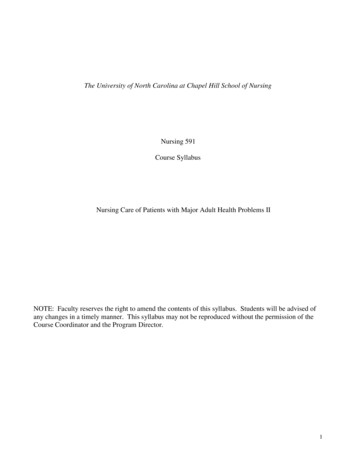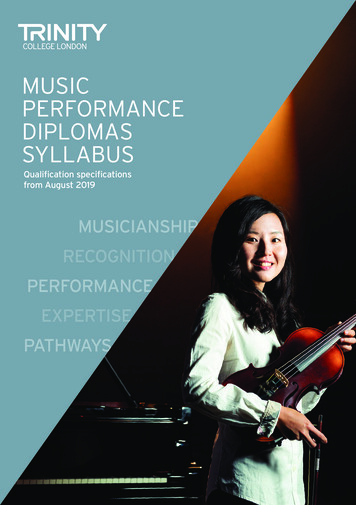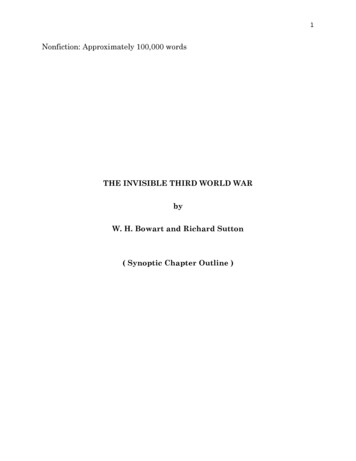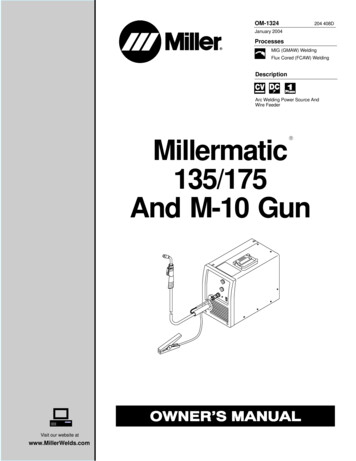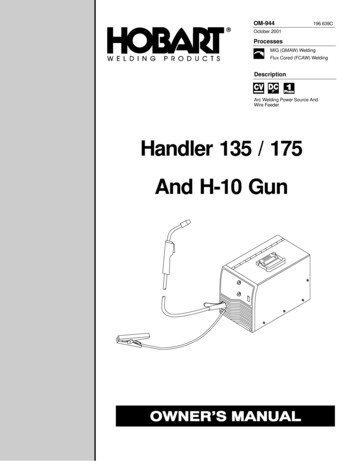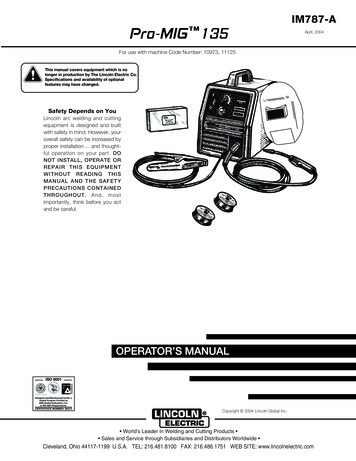
Transcription
Course ProspectusFor THL 135 Life, Ministry and Teachings of JesusFall Semester 2013OverviewThrough this course, a student encounters the JudeoChristianity of the Apostolic Period and explores the basicdoctrines of Jesus of Nazareth and his teaching of theindividuals he prepared as apostolic leaders of the Church ofGod. In this course a student encounters the Gospels in aholistic manner through a verse-by-verse analysis of thebiblical text. Use of a harmony of the Gospels provides thestudent with both a chronological approach to Jesus’ ministryand parallel accounts from the four Gospels. The course is anexcellent opportunity for serious students of the Bible todevelop a working familiarity of the culture of Jesus’ day andan understanding of the foundational truth of the Church ofGod which Jesus established.A model of the Temple at Jerusalem in Herodiantimes originally constructed by archeologistMichael Avi-Yonah at the Holyland Hotel. Now ondisplay at the Israel Museum.Course catalog description for this courseThis course covers the life, ministry, and teachings of JesusChrist as presented in the four Gospels. Emphasis is on the analysis of the four Gospels in the context ofthe social, political, and religious conditions of the first century. Upon completion, students should beable to explain the background, purpose, message, and themes of the Gospels and the significance ofJesus Christ in the first century and beyond. The lecture core of this course is a series of recordedlectures presented by noted television evangelist, author, and pastor of pastors Dr. Roderick C.Meredith.Prerequisites and corequisitesThere are no Prerequisites or Corequisites for this course.Course creditThree (3) semester hours.Instructional objectivesOn successful completion of this course, a student should be able to:1. Trace the events and statements involved in Jesus’ life in a logical and chronological sequence;2. Describe the significance of the words and works of Jesus Christ in light of the historical,geographical, and cultural context of the Gospels;3. Demonstrate an understanding of God’s overall plan of redemption and the implications of thebasic truths revealed in the earthly ministry of Jesus Christ;Page 1 of 8Copyright 2009-2013 Living University. All Rights Reserved. Course Prospectus andSyllabus Revised April 24, 2012; December 18, 2012; June 26, 2013.
Course Prospectus (THL 135- Life, Ministry and Teachings of Jesus)Fall Semester 20134. Show the harmony of the four gospels and dispel any questions of the so-called “contradictoryfacts” found in each of them;5. Demonstrate an understanding of how the life and ministry of Christ relates to prophecy, firstcentury Jewish and Christian life, and beyond;6. Demonstrate skill in the analysis and exegesis of key Bible passages in the Gospels; and7. Show mastery of the basic terminology of this course and the physical geography associatedwith the Gospels.Your instructorsThe principal lecturer for this team-taught course is senior evangelist Dr. Roderick C. Meredith. Dr.Meredith has taught this course to thousands of students over the span of four decades. His recordedlectures, designed specifically for this online course, help students master the details of the originalChristianity of the Church in the first century and explore the basic doctrines of Jesus of Nazareth andhis teaching of those he prepared as apostles and leaders of the early Church. He is assisted by Dr.Michael P. Germano who serves as the instructor of record. Michelle R. Broussard (LU’s AssistantRegistrar) serves as the instructional associate. To contact Dr. Germano or Mrs. Broussard on coursedetails and issues, please use the email feature in the E-Learning system (Populi).Dr. Roderick C. MeredithDr. Michael P. GermanoMichelle R. BroussardTechnology accessThis course requires web access and the student has to have an established e-mail account. The AdobeAcrobat Reader is necessary to view documents that are PDF files. One can download the reader free html.TextbooksIn this course there are three required textbooks. We also have listed three optional books that webelieve can help you consider the realities of the Biblical world in Jesus’ day. In the lessons we haveprovided you with links to electronic copies of various booklets and articles that are either required oroptional reading, so your basic cost is the three textbooks. If you decide to purchase the three optionalbooks we suggest paperback copies. There is no cost for the electronic copies of the booklets andarticles.Page 2 of 8Copyright 2009-2013 Living University. All Rights Reserved. Course Prospectus andSyllabus Revised April 24, 2012; December 18, 2012; June 26, 2013.
Course Prospectus (THL 135- Life, Ministry and Teachings of Jesus)Fall Semester 2013For theology courses students must have a Bible in addition to their textbooks. The theology facultyrecommends a New King James edition of the Bible (NKJ). There are many editions available, but forstudent use we suggest the NKJV Study Bible in either the regular or large print editions. The regular edition is available in Bonded Black Leather (ISBN 0718020804) at Christian Booksthrough the University Bookstore for about 47 plus sales tax and shipping charges (the normalretail cost is about 70). The large print edition NKJV Study Bible: Large Print Edition, Black Bonded Leather ThumbIndexed (ISBN 9781418542108) sells for about 55 plus sales tax at Christian Books through theUniversity Bookstore (normal retail is about 90).Commentaries normally can help you with a writing assignment. We have found three that have provenuseful. You might consider adding them to your library over time. The prices below are approximate.They are:New Bible Commentary. Eds. G. J. Wenham, J.A. Motyer, D.A. Carlson and R.T. France. 21stCentury Edition. Downers Grove: IVP Academic, 1994. ISBN: 978-0-8308-1442-8. Amazon: 29.70. Christian Books: 29.49.The Expositor’s Bible Commentary. Eds. Frank E. Gaebelein (general editor) and J. D. Douglas(associate editor). New Testament Set, 5 volumes. Grand Rapids: Zondervan. ISBN 0310365686.Amazon: 153.94. Christian Books: 117.99.Jamieson, Fausset & Brown’s Commentary. Grand Rapids: Zondervan, 1961. ISBN9780310265702. Amazon: 23.00. Christian Books; 19.49.Your textbooks for this course are:Elwell, Walter A., and Robert W. Yarbrough. Encountering the New Testament: A Historical andTheological Survey. 2nd ed. Grand Rapids: Baker Academic, 2005. ISBN 080102806X.andElwell, Walter A., and Robert W. Yarbrough. Readings from the First-Century World: PrimarySources for New Testament Study. Grand Rapids: Baker Academic, 1998. ISBN: 080102157X.andRobertson, A. T. A Harmony of the Gospels for Students of the Life of Christ (American StandardVersion). New York: Harper & Row, 1950. ISBN: 9780060668907.If you would like to have a harmony in modern English, the following has references in the lessons butthe order of this NASB Thomas & Gundry harmony is at times different than that of Robertson.Thomas, Robert L., and Stanley N. Gundry. A Harmony of the Gospels (New American StandardVersion). San Francisco: HarperSanFrancisco, 1991. ISBN 9780060635244.There are four other books, available in paperback, that we believe can be helpful in your considerationof some of the topics in this course and which should assist you in your study in other LU theologycourses. These books are optional, that is we list them for your consideration but they are not in anyway required. They are:Page 3 of 8Copyright 2009-2013 Living University. All Rights Reserved. Course Prospectus andSyllabus Revised April 24, 2012; December 18, 2012; June 26, 2013.
Course Prospectus (THL 135- Life, Ministry and Teachings of Jesus)Fall Semester 2013Fisher, George P. State of the Roman World at the Birth of Christ. Whitefish, MT: KessingerPublishing, 2003. ISBN 0766141764.Eldersheim, Alfred. The Life and Times of Jesus the Messiah: New Updated Edition. Peabody,MA: Hendrickson Publishers, 1993. ISBN 0943575834.Jeffers, James S. The Greco-Roman World of the New Testament Era: Exploring the Backgroundof Early Christianity. Downers Grove: IVP Academic, 1999. ISBN 0830815899.Gibbon, Edward. The Decline and Fall of the Roman Empire. Vol. 2. Rockville, MD: WildsidePress, 2004. ISBN 9780809592364.Stark, Rodney. The Rise of Christianity. New York: HarperOne, 1997. ISBN 0060677015.The textbooks, commentaries and reference books in this course are commercial publications. Theyrepresent the views and ideas of their authors, editors, and publishers. Living University does notendorse these publications nor does it vouch for their accuracy. We simply employ them in helpingstudents master the content of the course.As a Bible student, one needs to consult Bible dictionaries, commentaries, and biblically relatedmagazine or journal articles for information. When doing this a student has to sort out the wheat fromthe chaff. That is, the student must have sufficient grounding in the Bible to sort out the correct fromthe incorrect, the plausible from the implausible. This is a critical thinking skill, one we want students todevelop further in this course and in all LU courses.The basic textbook we selected, Elwell and Yarbrough’s Encountering the New Testament: A Historicaland Theological Survey, is a conservative approach written in an easy to read and well laid out fashion.This book has some material that is helpful, and some that is not. In the setting of this course, we wantstudents not only to discern the difference but also to know why there is a difference. Our quest is tohelp students to “rightly divide the word of God” (2 Tim. 2:15 KJV).Moreover, in daily life and particularly in the life of ministers, you will encounter people who identifywith the thinking of this book’s authors. For example, many if not most Protestants and Roman Catholicsbelieve that the Kingdom of God exists today and equate it with the church or salvation. We hold thatJesus and the Apostles taught primarily that the Kingdom of God was not to come into being until theSecond Coming of Jesus Christ. Part of a good theological and biblical education is coming to understandwhat others believe and why they believe it. You need to develop sufficient understanding and skills thatyou can demonstrate and effectively communicate what the truth of God is in such matters.We will only deal with Chapters 2, 3, and 9 in this course. We plan to use this same text in THL 136 (Actsand the Writings of Paul) and THL 332 (The Biblical Text), therefore, you should get a reasonable returnon your investment. Our suggestion is that you take the time to mark the text, correcting errors andunderlining helpful points, so it can be a useful handbook for you. The paper the publisher selected forthis text and its wide margins lend themselves to note taking. We suggest you use a fine point Pilot pen.Page 4 of 8Copyright 2009-2013 Living University. All Rights Reserved. Course Prospectus andSyllabus Revised April 24, 2012; December 18, 2012; June 26, 2013.
Course Prospectus (THL 135- Life, Ministry and Teachings of Jesus)Fall Semester 2013Course requirements and gradesDue dates and extensionsStudents must complete the course by the last official day of instruction as set forth in the academiccalendar.Reading assignmentsRefer to the “Course calendar” section for information about reading assignments. Final readingassignments are located on the lessons pages at the course website.Writing assignmentsAll writing assignments in this course should follow the MLA style as set forth in Writing ResearchPapers: A Complete Guide by Lester & Lester. Please cite your sources and use quotation marks whereneeded. The Files feature on an assignment page lets you submit your work so your instructor can haveit handy for download, review, and grading.Study tipsDistance learning emphasizes self-motivation. The instructor functions as a facilitator with the studentas the driving force in mastering course content. Students are encouraged not to put off completingtheir readings and assignments. While there are many different learning styles, the following strategyshould serve the needs of most students. Look over assigned readings. Read the assigned readings, making notes before viewing the assigned lecture. Define terms in the assignment. The three exams will specifically test basic terminology.Students should develop their biblical and theology vocabulary as they proceed assignment byassignment. As students view lectures, they should complete their notes. Complete the answers for the lesson writing assignment. Participate in course discussions. Each week students should review notes, geographical terms and locations, and the words theydefined. If a student has a question, ask. Questions should arise in the teaching-learning process. Bybringing questions to our attention, students not only acquire assistance but they also maintainthe interaction necessary in higher education. To submit a question just click on the instructor’sname on the “Course Info” page and send your question by email through the Populi system.LecturesThis course includes lectures by Dr. Meredith. Links to lectures are in the lessons. The lectures in thiscourse are expositions of the Gospels, using Robertson's A Harmony of the Gospels, providing studentswith a verse-by-verse analysis and explication of the Gospels. The focus is upon the literal content andmeaning of the written gospel texts in their first-century context. Students should use the opportunity tomake notes in their harmonies.Page 5 of 8Copyright 2009-2013 Living University. All Rights Reserved. Course Prospectus andSyllabus Revised April 24, 2012; December 18, 2012; June 26, 2013.
Course Prospectus (THL 135- Life, Ministry and Teachings of Jesus)Fall Semester 2013Quizzes and examinationsEach of the eight lessons has an associated online quiz of not more than 20 questions. They are openbook quizzes, but under no circumstances are students to print the quiz. An open book quiz is not aworkbook exercise. It is a test where the student can consult his or her notes and books. Students haveone hour to complete each quiz. Quizzes are multiple-choice questions covering lectures, readings,vocabulary words, and geographical terms and places.The three exams are closed book and you will need a proctor.GradingA course grade will be determined based on the number of points a student has earned over thesemester as follows:Icebreaker Assignment (30 points)Writing Assignments (eight, each worth 30 points, for a total of 240 points)Discussions (eight, each worth 10 points, for a total of 80 points)Exams (three, each worth 100 points, for a total of 300 points; online, closed book, must beproctored)Quizzes (eight, each worth 40 points, for a total of 320 points; online, open book]Course Evaluation (30 points)TOTAL 1,000 pointsGrades are in the traditional American style of an A, B, C, D, or F. In distance learning, we believe thatthe measure of mastery of course subject matter is completion of 80% of the objectives for a course.That means that we want students to earn at least 800 points in this course. If they do not do so thenthey have not achieved the level of the mastery we would like them to have.We want this course to be competency-based and so it is possible for the entire class to receive an A ora B. There is no artificial curving of scores in the assignment of grades (if you do not know what thatmeans, do not worry about it). Mastery of the material is what one’s goal should be.Grades, assigned by points, are as follows:A900 and overB800-899 pointsC700-799 pointsD600-699 pointsFBelow 600 pointsPage 6 of 8Copyright 2009-2013 Living University. All Rights Reserved. Course Prospectus andSyllabus Revised April 24, 2012; December 18, 2012; June 26, 2013.
Course Prospectus (THL 135- Life, Ministry and Teachings of Jesus)Fall Semester 2013Course calendarLessonLesson 1 Introduction (Aug. 14-29)Topic 1 The Near East in the Days of JesusTopic 2 The Gospel AccountsTopic 3 His Pre-Existence and Birth PreparationsTopic 4 Jesus’ Birth, Boyhood, and Baptism by JohnReadings (this is not an exhaustive list, some additional readings will beadded during the semester)Elwell & Yarbrough Chapter 2 (pp. 39-68)Comments on Elwell & Yarbrough Chapter 2Robertson §1 (p. 1) or Thomas & Gundry §1 (p. 19)Elwell & Yarbrough Chapter 3 (pp. 69-76)Comments on Elwell & Yarbrough Chapter 3Robertson §2 (p. 2)Armstrong Is Jesus God?Meredith Who Was the God of the Old Testament?Meredith Your Ultimate DestinyRobertson §§3-24 (pp. 3-20)Ogwyn Is Christmas Christian?Lesson 2 Christ at Jerusalem, in Samaria and His Arrival at Galilee (Aug. 30-Sep. 13)Topic 1 The Temptation & His Travel to CapernaumRobertson §§25-30 (pp. 20-24)Meredith Do You Believe the True Gospel?Topic 2 First Cleansing of the Temple at PassoverRobertson §31 (p. 25)Pritz Who Is a Jew in the Gospels?Topic 3 Nicodemus Seeks Out Jesus and JohnRobertson §§32-33 (pp. 25-27)SupersededOgwyn What Do You Mean – “Born Again”?Topic 4 Jesus Departs Judea, in Samaria at Jacob’s WellRobertson §§34-39 (pp. 27-32)and Sychar, and His Opposition at NazarethSafrai Synagogue and SabbathLesson 3 Beginning of Christ’s Ministry in Galilee (Oct. 1-13)Topic 1 A New Headquarters, Disciples Called, andMinistry Throughout GalileeTopic 2 Sabbath Controversies and WithdrawalTopic 3 Appointment of “The Twelve”Topic 4 Sermon on the MountRobertson §§40-48 (pp. 32-41)Robertson §§49-52 (pp. 42-47)Meredith Which Day is the Christian Sabbath?Robertson §53 (pp. 47-48)Robertson §54 (pp. 48-55)Meredith What Is a True Christian?EXAM 1 Covering Lessons 1-3 (100 points). Time for completion: 1 hour (60 minutes).Lesson 4 Jewish Conflicts & The Kingdom of God (Oct. 14-27)Topic 1 Growing Reputation and Emphasis onRepentanceTopic 2 Public Rejection by Jewish LeadersTopic 3 Parables and The Kingdom of GodTopic 4 Continuing OppositionRobertson §§55-60 (pp. 55-61)Elwell & Yarbrough Chapter 9 (pp. 137-151)Comments on Elwell & Yarbrough Chapter 9Laughlin “Capernaum: From Jesus’ Time and After.” BiblicalArchaeology Review 19:05 (Sep/Oct 1993).Robertson §§61-63 (pp. 61-64)Ogwyn Lessons from the Parables of the KingdomMeredith God’s Kingdom is a Real GovernmentRobertson §64 (pp. 64-70)Robertson §§65-71 (pp. 70-84)Page 7 of 8Copyright 2009-2013 Living University. All Rights Reserved. Course Prospectus andSyllabus Revised April 24, 2012; December 18, 2012; June 26, 2013.
Course Prospectus (THL 135- Life, Ministry and Teachings of Jesus)Fall Semester 2013Lesson 5 The Ministry of Christ Around Galilee (Oct. 28-Nov. 10)Topic 1Teaching Around the Sea of GalileeRobertson §§72-77 (pp. 85-94)Topic 2 Ministry in Gentile TerritoriesRobertson §§78-81 (pp. 94-99)Topic 3 Special Training of the TwelveRobertson §§82-95 (pp. 99-113)Topic 4 Feast of Tabernacles at JerusalemRobertson §§96-101 (pp. 114-120)Lesson 6 Concluding Ministry in Judea, Perea and Jerusalem (Nov. 11-24)Topic 1 Later Judean MinistryRobertson §§102-111 (pp. 120-130)Ames The Unpardonable SinTopic 2 Perean MinistryRobertson §§112-116 (pp. 131-135)Buth That Small-fry Herod Antipas, or When a Fox Is Not a FoxTopic 3 Lazarus and the Rich ManRobertson §§117-121 (pp. 135-141)Armstrong Lazarus and the Rich ManRobertson §§122-142 (pp. 141-188)Topic 4 At Jerusalem Before PassoverMeredith Prophecy Fulfilled: God's Hand in World AffairsEXAM 2 Covering Lessons 4-6 (100 points). Time for completion: 1 hour (60 minutes).Lesson 7 The Last Supper, His Arrest and Trials (Nov. 25-Dec. 8)Topic 1 The First Christian Passover: Its Purpose andRobertson §§143-152 (pp. 189-204)MeaningTopic 2 The First Christian Passover: Its ChronologyChart of the Crucifixion/Resurrection WeekEvents of the Crucifixion/Resurrection WeekTopic 3 Jesus’ ArrestRobertson §153 (pp. 205-208)Topic 4 Jesus’ TrialsRobertson §§154-162 (pp. 209-226)Hoeh Twelve Reasons Why Jesus’ Trial was IllegalLesson 8 The Death, Resurrection and Ascension of Jesus Christ (Dec. 9-18)Topic 1 The Crucifixion and BurialRobertson §§163-168 (pp. 226-238)Germano Draft Section of The First Christians Chapter 4Topic 2 The ResurrectionRobertson §§169-172 (pp. 239-242)Ogwyn The Resurrection Was Not on EasterSunday!Topic 3 Post-Resurrection AppearancesRobertson §§173-183 (pp. 242-251)Elwell & Yarbrough Chapter 8 (pp. 132-133)Topic 4 The AscensionRobertson § 184 (pp. 251-252)EXAM 3 Covering Lessons 7-8 (100 points). Time for completion: 1 hour (60 minutes).Page 8 of 8Copyright 2009-2013 Living University. All Rights Reserved. Course Prospectus andSyllabus Revised April 24, 2012; December 18, 2012; June 26, 2013.
For THL 135 Life, Ministry and Teachings of Jesus Fall Semester 2013 Overview Through this course, a student encounters the Judeo-Christianity of the Apostolic Period and explores the basic doctrines of Jesus of Nazareth and his teaching of the individua




